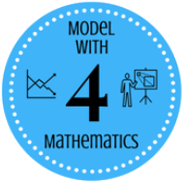Students define the shapes used to build a rectangular prism, print them, cut them out, and build the rectangular prism. Then they use their model to calculate the surface area.
Lesson Goals |
Students will be able to:
|
|||||||||||||||
Student-facing Goals |
|
|||||||||||||||
Materials |
|
|||||||||||||||
Preparation |
|
|||||||||||||||
Key Points For The Facilitator |
|
|||||||||||||||
Language Table |
|
- face
-
the shapes on the outside of a figure
- rectangular prism
-
a solid figure which has 6 faces, all of which are rectangular
- surface area
-
the sum of the areas of the faces of a polyhedron or the total area that the surface of a solid object occupies
🔗Surface Area
Overview
Students build on their experience with writing code to define shapes. They will define shapes for all of the faces of a rectangular prism, print them, cut them out, and build the rectangular prism. Then they will use their model to calculate the surface area and write code to do the same.
Launch
Students should open the Prism Starter File (Pyret) in their browser and click run.
Click run and type prism into the Interactions Area to see an image of a rectangular prism. Notice that the faces and dimensions (Length, Width, and Height) are labeled.
Faces are the shapes on the outside of the figure. Edges are the line segments where the faces of solid figures meet in each of the three dimensions.
-
How would you describe the faces of this prism?
-
Skip down to the code on line 22. It reads
lst = [list: front, ], which defineslstto be a list of values. This list will include all of the faces of the prism, but right now it only includesfront. Add the names of each of the remaining faces to the list. (Order doesn’t matter.) -
Once you complete your list, go back up to line 20 and look at the definition for
front. Typefrontinto the interactions area. What do you get? -
Just as
fronthas been defined to draw a rectangle whose dimensions arewidthandheight, you will need to write definitions for each of the other faces of the prism the you put on your list. Start adding definitions on line 21 and add a line for each definition so that all of the faces are defined betweenfrontandlst. Click run and test each of them in the interactions area to make sure that they match the prism you started with.
Facilitation Note
The sample definition was written to make the image of an outlined rectangle with a black and white printer in mind. If you have access to a color printer in your classroom, you may want students to change the code of |
-
When you’ve finished, click Run and type
print-imgs(lst). What do you Notice? What do you Wonder? -
Do you have enough shapes to cover all of the faces of the prism?
-
Read the comments in the file to learn how to customize and print the faces to build your prism.
Investigate
Have students cut out and tape together the images they defined to form a 3-dimensional paper model of a rectangular prism.
Students will then use their models to calculate the surface area.
Supporting students with learning variations
|
-
Once you’ve built your prism, use it to help you calculate the surface area of the figure. Then, turn to task 2 in the Prism Starter File and define surface area to calculate the area of the prism using width, length and height.
Synthesize
Have students share the codes they wrote to define surface area. Did students all write the code the same way? Can anyone see other ways that they could have written the code?
-
How did building the prism help you to understand surface area?
-
How did writing the code for surface area help you to understand surface area?
These materials were developed partly through support of the National Science Foundation,
(awards 1042210, 1535276, 1648684, and 1738598).  Bootstrap:Algebra by the Bootstrap Community is licensed under a Creative Commons 4.0 Unported License. This license does not grant permission to run training or professional development. Offering training or professional development with materials substantially derived from Bootstrap must be approved in writing by a Bootstrap Director. Permissions beyond the scope of this license, such as to run training, may be available by contacting contact@BootstrapWorld.org.
Bootstrap:Algebra by the Bootstrap Community is licensed under a Creative Commons 4.0 Unported License. This license does not grant permission to run training or professional development. Offering training or professional development with materials substantially derived from Bootstrap must be approved in writing by a Bootstrap Director. Permissions beyond the scope of this license, such as to run training, may be available by contacting contact@BootstrapWorld.org.

